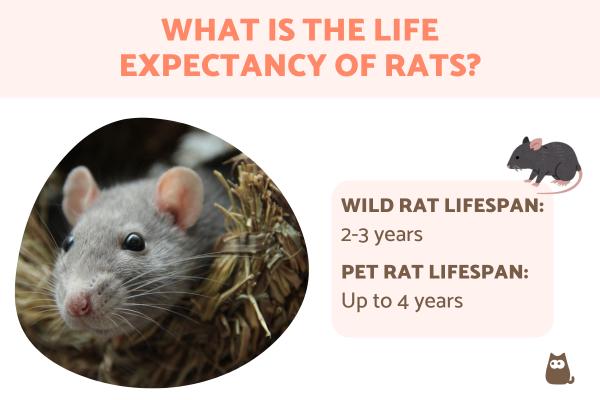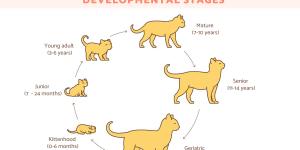What Is the Life Expectancy of Rats?


The average life expectancy of rats can be up to three years of age, but this will depend on various factors. One of the most important is whether they are wild or pet rats. This is because the lifestyle of these different rat types has a great bearing on their health and well-being. Rats of the genus Rattus are found all over the world and have adapted to various ecosystems. They are the supreme survivors with a great resistance to disease. Unfortunately, they can be vectors for diseases, something which is especially dangerous to human populations. Genes related to aging, diet and other factors will influence the average lifespan of rats.
At AnimalWised, we investigate what is the life expectancy of rats? We look at the factors that affect how long a rat will live, making a specific comparison between pet rat and wild rat lifespans.
The life cycle of rats
Also known as the common rat, the brown rat (Rattus norvegicus) is one of the most common rats in the world. Along with the black rat (Rattus rattus), they have an almost global distribution and often in very high numbers. They have adapted particularly well to live in human settlements since they can scavenge on waste left by humans.
The average lifespan of a rat will depend on a healthy development, whether in the wild or as a domestic pet. The following are the stages of the rat life cycle which explains their great adaptability and reproductive success:
- Birth and development: like most mammals, rats begin their life cycle as newborn pups. The gestation period varies depending on the species, but generally lasts about three weeks. The young are altricial, meaning they are born blind, hairless and entirely dependent on the mother for care and feeding.
- Childhood and adolescence: as rat pups grow, they enter a phase of juvenile development. During this time, they begin to explore their environment, develop motor skills and learn social behaviors, such as interacting with other members of the colony. The mother plays a crucial role in teaching skills and providing care until the offspring are sufficiently independent to leave them.
- Sexual maturity: rats reach sexual maturity relatively quickly. Depending on the species, this can occur within only a few weeks or months after birth. Once they reach sexual maturity, rats are ready to participate in the reproductive process.
- Reproduction: rats are known for their ability to reproduce quickly and prolifically. They can have litters several times a year, with each litter consistently bearing multiple offspring. The gestation period of rats is short and they are able to reproduce again shortly after giving birth.
- Adult life: this stage is marked by the search for food, social interaction and adaptation to the environment. Rats are highly intelligent and adaptive animals, allowing them to adapt and survive in various habitats. Learn about what rats eat in the wild to best ensure their survival.
- Aging and continuous cycle: as rats age, their reproductive capacity and vitality may decrease. However, the adaptability and resilience of these rodents allow them to face a variety of challenges throughout their lives. The rat life cycle continues with the reproduction of new generations, ensuring the survival and prosperity of the colony.
This dynamic and adaptable life cycle of rats contributes to their success as a species. Their ability to reproduce rapidly and adapt to diverse environments has led to their global distribution and close coexistence with people. Living in such close proximity can cause problems, such as spreading certain diseases from rats to humans.
What is the lifespan of a rat according to species?
The average lifespan of a rat varies depending on the species, environmental conditions and whether they live in a controlled environment or the wild. The life expectancy of rats we provide are general estimates. Variability is significant depending on specific environmental conditions, the presence of predators, food availability and other factors.
Additionally, domesticated rats in controlled environments can live longer than their wild counterparts due to the absence of natural threats. We can now look at the average lifespan of different rat species:
- Brown rat (Rattus norvegicus): in controlled environments, brown rats can live 2 to 3 years. In the wild, their lifespan tends to be shorter due to predators, diseases and adverse conditions.
- Black rat (Rattus rattus): the lifespan of the black rat can range from 12 to 16 months under natural conditions.
- Savile's bandicoot rat (Bandicota savilei): the lifespan of this species can vary, in the wild they have been recorded to live up to 2 years.
- Marsh rice rat (Oryzomys palustris): not in the genus Rattus, but they are considered a type of rat, mice rats have a life expectancy of around 1 to 2 years in the wild.
- Hispid cotton rat (Sigmodon hispidus): this species is found in Central and North America and has a lifespan of about 1 to 2 years in the wild.
How long do rats live in the wild?
As with other rat species, the average life expectancy of brown rats in the wild can vary significantly due to various factors. These include food availability, the presence of predators, environmental conditions and exposure to disease. In urban and rural environments, street rats often interact closely with humans. For this reason, their lives may be subject to additional challenges such as pest control services.
Under natural conditions and without human intervention, the lifespan of this type of rats is usually shorter compared to rats living in controlled environments. This is due to the exposure to the various threats, including predation by other animals. On average, the life expectancy of brown and black rats in the wild can range from a few months to 2 years.
It is essential to note that rat lifespan estimates may vary depending on geographic location and specific environmental conditions. Additionally, rats are known for their great adaptability. Their ability to find food and shelter may influence their survival in urban environments.
Including life expectancy, learn more about different types of rodent with our article on the differences between rats and mice.

How long do pet rats live?
Although there are different types of domestic rat, they all stem from the same species which is the brown rat (Rattus norvegicus). This domestic breed of the wild rat is known as the fancy rat (Rattus norvegicus domestica). While they all stem from the same species, there are different breeds which can vary greatly in terms of appearance and even behavior.
Taking the average of all these types, we can say the domestic rat can live an average of up to 4 years. As with wild rats, there are several factors that influence the lifespan of a pet rat. Genetics play a significant role, with some breeding programs leading to problems which can alter the life expectancy of rat breeds. This is because they become predisposed to certain health problems which can affect longevity.
If we have rats as pets, providing a balanced diet is essential. Rats are omnivorous animals and need a diet that includes rat pellets, fruits, vegetables and protein. It is also important to avoid foods that are toxic to them. Learn more with our article on what can I feed my pet rat?
A clean and safe environment contributes to the health of rats. Providing a spacious cage with items on which they can gnaw is essential. Additionally, keeping the cage clean and providing regular exercise helps prevent health problems.
Proper veterinary care can also make a difference in the lifespan of a domestic rat. Regular checkups and immediate attention to health problems can help prevent and treat illness. These are not options available to rats in the wild and are a significant factor in the increased life expectancy of domestic rats.

If you want to read similar articles to What Is the Life Expectancy of Rats?, we recommend you visit our Facts about the animal kingdom category.
- Berdoy, M., & Drickamer, LC (2007). Comparative social organization and life history of Rattus and Mus . Rodent societies: an ecological and evolutionary perspective, 380-392.
- Feng, A.Y., & Himsworth, C.G. (2014). The secret life of the city rat: a review of the ecology of urban Norway and black rats (Rattus norvegicus and Rattus rattus) . Urban Ecosystems, 17, 149-162.
- Kwekel, JC, Desai, VG, Moland, CL, Branham, WS, & Fuscoe, JC (2010). Age and sex dependent changes in liver gene expression during the life cycle of the rat . BMC genomics, 11, 1-15.






